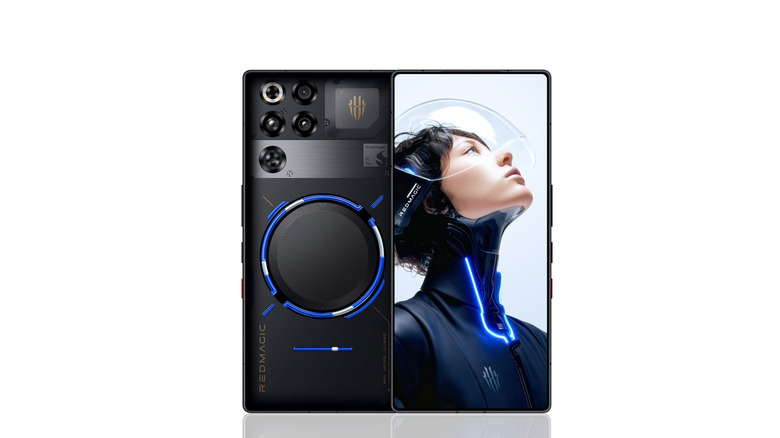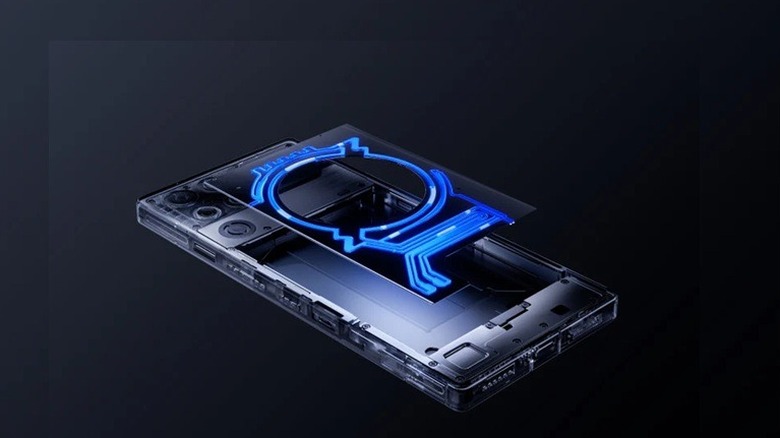The World's First Liquid-Cooled Smartphone Is About To Hit The Market
The RedMagic 11 Pro is set to launch in the United States on November 3rd, 2025, when it will introduce the world to some truly state-of-the-art technology. The fancy new smartphone is largely geared towards mobile gamers. It includes a Snapdragon 8 Elite Gen5 system-on-a-chip (SoC), which is considered by many to be the world's fastest chipset for mobile devices, as well as a RedCore R4 dedicated graphics chip. However, its most innovative feature is the "world's first mass-produced liquid cooling" system, which is combined with a literal cooling fan to keep that powerful processor running efficiently.
Liquid cooling has been used in PCs for decades, though it's usually only necessary for the high-intensity processing involved in gaming and media production. Until the RedMagic 11 Pro, however, most mobile phones used neither liquid cooling nor fans. The closest that smartphones have gotten thus far is vapor chamber cooling. Because their CPUs generate less heat than personal computers, smartphones rely on passive cooling, which is when heat naturally dissipates throughout the components. That's why you might notice your phone getting warm when you run several intensive apps at once.
However, it seems mobile processors have outpaced the age of passive cooling. Currently, the fastest phones available in the United States are those with the Snapdragon 8 Elite mobile processors — the RedMagic 11 Pro uses the latest (the 5th generation). And now that new phones are combining such powerful processors with powerful graphics chips, liquid-cooled mobile devices are an inevitability. The RedMagic 11 Pro just happens to be the first.
The high-end specs of a phone built for next-gen gaming
Although it's been shrunk in size to fit inside a phone, the RedMagic 11 Pro's AquaCore liquid-cooling system is fundamentally the same as those found in servers and PCs. In fact, you can even see the fluid moving through its tubes on the back panel of the phone, just as with many fancy gaming PCs. To expel the heat, a 24,000rpm fan blows air out from the back.
Surprisingly, Nubia, the company behind the RedMagic line, managed to keep the phone's dimensions relatively slim. At 8.9mm thick and 230 grams in weight, the RedMagic 11 Pro doesn't exactly match up with the super-skinny profile of the newly-released iPhone Air, but it's still quite compact considering how much heavy-duty hardware is packed into its body. That includes a huge 7,500mAh battery, which the company claims can deliver over 13 hours of continuous gaming.
It would seem that RedMagic is seeking to grow its reputation as the top choice for mobile gaming. The RedMagic 11 Pro's release follows that of the RedMagic Astra, a tablet with high-end gaming specs and a competitive price. Like the Astra, the RedMagic 11 Pro has an extremely advanced touchscreen. The company's launch announcement includes fancy-sounding features like "under-screen tech" and "eye-friendly visuals," but the bottom line for gamers is the 144Hz refresh rate and the 1.5K resolution (specifically, 2,688 x 1,216 pixels). The panel itself is AMOLED, which is better at reducing motion blur compared to conventional OLED screens. Unlike the Astra, however, the RedMagic 11 is far from cheap.
Variants and prices: High-end specs are expensive
The global release of the RedMagic 11 Pro will be slightly different from the already-released Chinese model. In China, two variants are available: the Pro and the Pro+. The main difference between the two surrounds the battery. The Pro is restricted to 80W wired charging, while the Pro+ supports 120W fast-charging. However, so far, Nubia has not officially announced a global release of the Pro+. Furthermore, the company appears to have quietly reduced the Pro's 8,000mAh battery on its Chinese model to 7,500mAh for its global release to conform to trade regulations.
The price of the RedMagic 11 Pro global model is also yet to be determined, but we can expect it to cost about the same as the Chinese model. In China, the base model comes with 12GB of RAM and 256GB of storage and retails for around $700, while the 16GB/512GB option costs around $800. Should the Pro+ never see a global release, we hope some of its upgraded features will still make it to the Western world. In China, an edition of the Pro+ is available with 24GB of RAM and an entire terabyte of storage. It costs over $1,000 dollars, but, for serious mobile gamers, such specs are worth the price.


